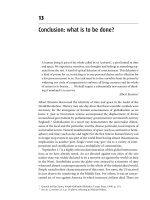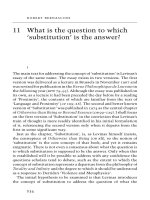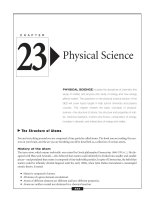2 9 what is energy (physical science)
Bạn đang xem bản rút gọn của tài liệu. Xem và tải ngay bản đầy đủ của tài liệu tại đây (3.16 MB, 14 trang )
Genre
Nonfiction
Comprehension Skill
Infer
Text Features
•
•
•
•
Call Outs
Captions
Labels
Glossary
Science Content
Energy
Scott Foresman Science 2.9
ISBN 0-328-13794-4
ì<(sk$m)=bdhjeh< +^-Ä-U-Ä-U
Vocabulary
conductor
energy
fuel
reflect
shadow
solar energy
source
What did you learn?
1. How do plants and animals get
energy?
2. What are some kinds of energy?
3.
change during the day. In your
own words, write to explain why
this happens.
4.
Picture Credits
Every effort has been made to secure permission and provide appropriate credit for photographic material.
The publisher deeply regrets any omission and pledges to correct errors called to its attention in subsequent editions.
Photo locators denoted as follows: Top (T), Center (C), Bottom (B), Left (L), Right (R), Background (Bkgd).
11 (BR) ©Comstock Inc.; 12 Sally Lancaster/Alamy Images; 14 (CL) Getty Images; 19 (BR) Getty Images; 21 (BR) ©Judith
Miller/Branksome Antiques/DK Images; 23 (TL) Getty Images.
Scott Foresman/Dorling Kindersley would also like to thank: 1 Pitt Rivers Museum, Oxford/DK Images; 4 Phil Farrand/
DK Images; 5 (TR) NASA/DK Images; 14 Pitt Rivers Museum, Oxford/DK Images; 15 Jane Bull/DK Images.
Unless otherwise acknowledged, all photographs are the copyright © of Dorling Kindersley, a division of Pearson.
ISBN: 0-328-13794-4
Copyright © Pearson Education, Inc. All Rights Reserved. Printed in the United States of America.
This publication is protected by Copyright, and permission should be obtained from the publisher prior to any
prohibited reproduction, storage in a retrieval system, or transmission in any form by any means, electronic,
mechanical, photocopying, recording, or likewise. For information regarding permission(s), write to
Permissions Department, Scott Foresman, 1900 East Lake Avenue, Glenview, Illinois 60025.
3 4 5 6 7 8 9 10 V010 13 12 11 10 09 08 07 06 05
by Christian
Downey
Shadows
Infer What can you infer
about someone wearing dark
blue clothing on a hot, sunny
day? How will that person feel?
Energy
You use energy all the time. You use energy
when you talk. You use energy when you eat.
Anything that can do work or cause change
has energy.
2
You use energy when you walk, run, or
play sports. You use energy when you think.
You even use energy when you sleep!
3
Solar Energy
solar panel
Earth gets energy from the Sun. Energy from
the Sun is called solar energy. Solar energy
is heat and light. People can use the Sun’s
energy to make things work.
Without the Sun, Earth
would be dark and cold.
solar-powered calculator
The calculator above uses the Sun’s energy
to work. The solar panel traps the solar energy.
The car below also uses the Sun’s energy to work.
solar panel
solar-powered car
4
5
Living Things
Use Energy
All living things need energy. Green plants
use energy to live, grow, and make food. Green
plants get energy from the Sun. They make food
using sunlight, air, and water.
Animals use energy to live, grow, and move.
Animals get energy from food. Some animals
get energy from eating green plants. People use
energy too.
All living things need energy to live.
6
7
People Get Energy from Food
Food gives us energy. When you get energy
from food, you can work, play, and grow.
Different kinds of food keep your body healthy.
There are five important food groups.
Your body needs food from all these groups.
If you eat too many sweets or foods from
one group, you may not stay healthy.
If you eat
healthful food,
you will have
lots of energy.
8
9
The Five
Food Groups
This picture shows
foods from the five
food groups. Which
foods did you eat today?
4
Vegetables have
vitamins that
your body needs.
1
Meat, fish, eggs,
and dry beans help
your body grow.
2
5
Milk, yogurt, and
cheese help your
teeth and bones
grow strong.
Fruits have vitamins
and minerals that
your body needs.
3
Bread, rice, cereals,
and pasta give
your body energy.
10
11
Sources of Heat
wood
A source is a place from which
something comes. Heat can come from
the Sun. The Sun is one source of heat.
Heat can come from other sources too.
Heat can come from a stove. Heat can
come from a fire.
A stove is
a source
of heat.
oil
coal
Some stoves use gas. Gas is a kind of fuel.
A fuel is something that is burned to make heat.
Wood, oil, and coal can also be used as fuel.
12
13
Heat Moves
Heat moves from hot places and objects
to cooler places and objects. In this picture,
heat is moving from the fire to the marshmallows.
Some materials are heat conductors.
A conductor is a material that allows heat
to pass easily through it. The cookie tray
in this picture is made of metal. Metal is
a conductor. The tray lets heat get to the
cookies. The oven mitts are not conductors.
Heat cannot move easily through them.
Oven mitts can protect
our hands from heat
because they are not
good conductors.
14
15
Light
Light moves in straight lines.
It can move through things
that are clear. Light can move
through glass or water.
Sometimes light hits an object
it cannot go through. Light will
bounce, or reflect, off the object.
Light is a kind of energy.
Light can come from a candle,
a lamp, or the Sun. Most sources
of heat also give off light.
Candles and lamps
are sources of
light and heat.
A mirror is not clear.
Light cannot go through it.
Light reflects off a mirror.
flashlight
mirror
16
17
The light we see is called
white light. But it is made up of
many different colors. This prism
is bending the sunlight. The light
becomes separated into its colors.
How many colors can you see?
Light reflects off light colors.
The next time you are hot, wear
something white. You will
feel cooler.
Light does not reflect as much off
dark colors. If you wear something dark
on a hot, sunny day, you will get even hotter!
prism
Raindrops can act like prisms to make rainbows. The
raindrops bend the light and separate it into its colors.
18
Light-colored clothes
reflect light from the Sun.
19
Shadows
A shadow is made when something blocks
a source of light. You can make a shadow
by blocking light with your body. You can play
with shadows using a flashlight.
morning
noon
afternoon
Shadows change during the day. In the early
morning, light from the Sun makes long shadows.
At noon the Sun shines directly above us.
Shadows are very short. The sunlight cannot easily
be blocked. In the late afternoon, long shadows
can be made again. It becomes
easier to block the sunlight.
This sundial works by using
changing shadows.
20
21
Other Kinds
of Energy
Some other kinds of energy are
motion, wind, sound, and electricity.
A kite uses
wind energy
to move.
This drum can make sound.
Sound is a kind of energy.
22
It is important to use electricity
safely. Keep things that use
electricity, like this CD player,
away from water. Never touch
a cord that has a wire showing!
When you throw a
ball, you give the ball
the energy of motion.
All living things need and use energy. Energy
comes from many different sources. The most
important source of energy is the Sun.
Did you use light or heat from the Sun today?
Did you use electricity? Pay attention to the
sources of energy you use. Energy is all around us!
23
Vocabulary
Glossary
conductor
energy
conductor
a material that lets heat
fuel
move easily through it
reflect
shadow
energy
anything that can do work
solar energyor cause change
source
fuel
something that is burned to
make heat
reflect
to bounce back from a surface
shadow
a dark area that forms when
a light source is blocked
solar energy heat and light from the Sun
Picture Credits
Every effort has been made to secure permission and provide appropriate credit for photographic material.
The publisher deeply regrets any omission and pledges to correct errors called to its attention in subsequent editions.
Photo locators denoted as follows: Top (T), Center (C), Bottom (B), Left (L), Right (R), Background (Bkgd).
source
a place from which something
comes
11 (BR) ©Comstock Inc.; 12 Sally Lancaster/Alamy Images; 14 (CL) Getty Images; 19 (BR) Getty Images; 21 (BR) ©Judith
Miller/Branksome Antiques/DK Images; 23 (TL) Getty Images.
Scott Foresman/Dorling Kindersley would also like to thank: 1 Pitt Rivers Museum, Oxford/DK Images; 4 Phil Farrand/
DK Images; 5 (TR) NASA/DK Images; 14 Pitt Rivers Museum, Oxford/DK Images; 15 Jane Bull/DK Images.
Unless otherwise acknowledged, all photographs are the copyright © of Dorling Kindersley, a division of Pearson.
ISBN: 0-328-13794-4
Copyright © Pearson Education, Inc. All Rights Reserved. Printed in the United States of America.
This publication is protected by Copyright, and permission should be obtained from the publisher prior to any
prohibited reproduction, storage in a retrieval system, or transmission in any form by any means, electronic,
mechanical, photocopying, recording, or likewise. For information regarding permission(s), write to
Permissions Department, Scott Foresman, 1900 East Lake Avenue, Glenview, Illinois 60025.
24
3 4 5 6 7 8 9 10 V010 13 12 11 10 09 08 07 06 05
What did you learn?
1. How do plants and animals get
energy?
2. What are some kinds of energy?
3.
Shadows
change during the day. In your
own words, write to explain why
this happens.
4.
Infer What can you infer
about someone wearing dark
blue clothing on a hot, sunny
day? How will that person feel?









